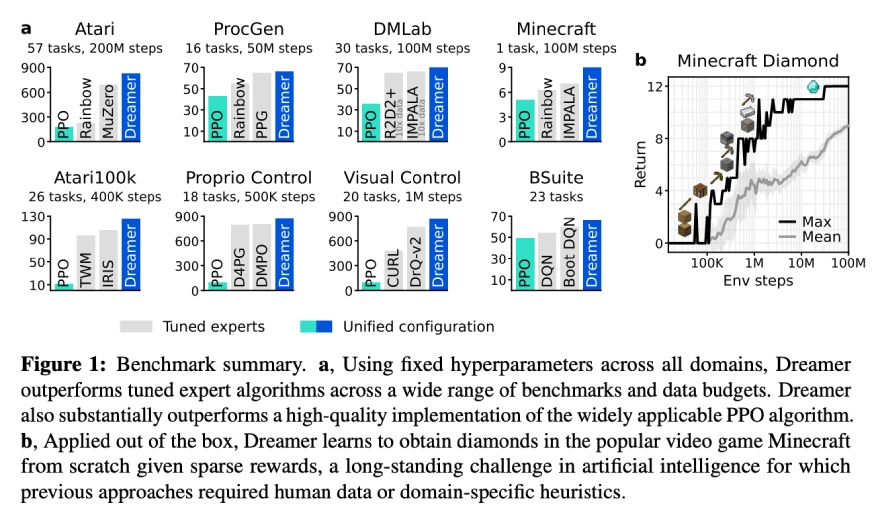What if I told you that AI can now outperform humans in some of the most complex video games? AI now masters Minecraft too. It is a game where players explore, mine, build, and craft with the goal of finding rare diamonds. Until recently, training AI for Minecraft needed lots of human data and custom setups. DeepMind changed that. Their new algorithm, DreamerV3, learned the game from scratch. No tutorials. No human input. Just the game. Here’s how it works.
Table of contents
Achieving the Minecraft Diamond Challenge
The “diamond challenge” in Minecraft—finding diamonds entirely autonomously—has historically been considered extremely difficult due to its complexity and minimal guidance within the game. Diamonds, located deep underground, require players to advance through a series of steps involving resource gathering, tool crafting, and survival strategies.
DreamerV3 achieved this challenging milestone with no direct human training data or predefined paths. The AI autonomously learned to progress through the entire technology tree in Minecraft. It began by collecting basic resources like logs, advanced to crafting essential tools such as pickaxes, then mined valuable resources like iron, and finally, successfully located and mined diamonds.

What is DeepMind’s DreamerV3 Algorithm?
DreamerV3 is a versatile reinforcement learning algorithm developed by Google’s DeepMind. It is distinguished by its capability to handle a wide variety of complex tasks without needing customized adjustments for each specific scenario or extensive human-generated training datasets. Its efficiency and adaptability enable it to tackle challenges ranging from gaming and simulations to real-world robotics.
Detailed Breakdown: How DreamerV3 Works?
DreamerV3 employs a unified approach to learn and master diverse tasks:
World Model Construction
DreamerV3 constructs an internal “world model,” allowing it to understand and predict how the environment operates. This model is built from direct pixel-level observations taken from the game. It captures the underlying dynamics of the game world, enabling it to recognize important patterns, objects, and interactions.
Predictive Simulation and Imagination
Using its world model, DreamerV3 can simulate future events and actions without directly interacting with the environment. It “imagines” potential outcomes based on different choices, effectively predicting the consequences of its actions beforehand. This capability allows it to explore different strategies internally, greatly improving its efficiency.
Decision-Making through Neural Networks
DreamerV3 comprises three integrated neural networks that support decision-making:
- Encoder and Decoder Networks: Convert complex observations, such as images from the game, into compact and useful internal representations.
- Sequence Model: Predicts the outcomes of sequences of actions, maintaining consistency across predictions to enable coherent planning.
- Actor-Critic Networks: The actor network selects the actions likely to yield the highest rewards, guided by the critic network, which assesses the value of different action outcomes to inform better decision-making.
Addressing Minecraft’s Unique Challenges
Minecraft presents unique and challenging features for AI:
- Sparse Rewards: The game rarely provides explicit feedback, making it difficult for AI to measure its progress.
- Complex Goal Structures: Finding diamonds involves a series of intermediate steps and careful planning, making long-term strategic thinking essential.
- Infinite Variation: Every Minecraft world is procedurally generated and infinitely diverse, adding significant complexity and unpredictability.
DreamerV3 effectively addresses these challenges:
- Robustness Techniques: The algorithm employs normalization and balancing methods, enabling stable performance across different scenarios and minimizing manual tuning requirements.
- Generalized Learning Capabilities: DreamerV3’s learned knowledge transfers effectively across different environments, allowing it to perform well in varied tasks ranging from video games to robotic control systems.
Broader Implications and Real-World Applications
The success of DreamerV3 holds broader implications beyond Minecraft:
- Adaptive Problem-solving: Its generalized learning approach makes it highly valuable in real-world applications like robotics, where tasks vary widely, and manual programming is impractical.
- Resource Efficiency: DreamerV3 reduces the computational resources and manual effort needed, making powerful AI tools more accessible to researchers, developers, and businesses.
Conclusion
Google’s DreamerV3 marks a significant advancement in artificial intelligence research by autonomously mastering Minecraft. It exemplifies the capabilities of general-purpose AI algorithms to learn complex tasks without human intervention, highlighting their potential to effectively and efficiently address diverse and challenging real-world problems.









